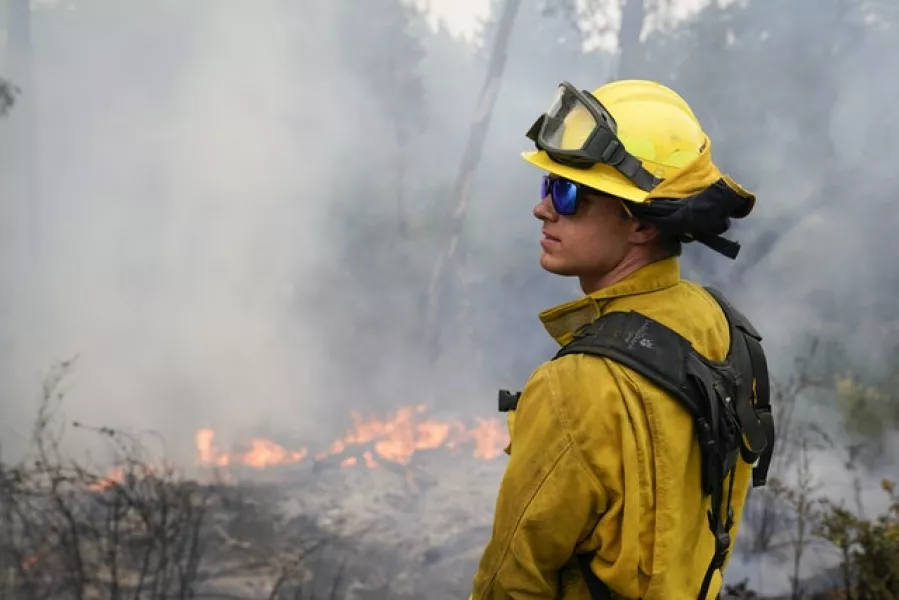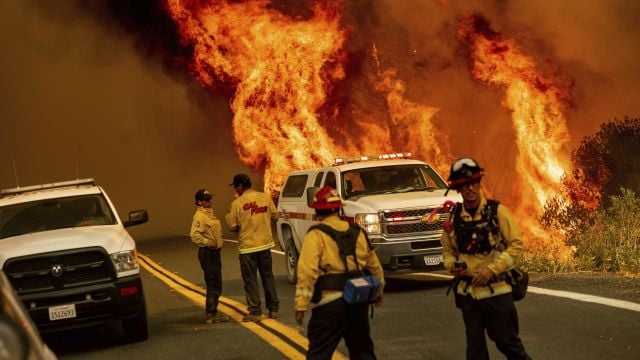That system was packing high winds and more of the lightning that sparked the huge blazes and scores of other fires around the state, putting nearly a quarter-million people under evacuation orders and warnings.
At the CZU Lightning Complex fire in the Santa Cruz Mountains, south of San Francisco, authorities announced the discovery of the body of a 70-year-old man in a remote area called Last Chance.
The man had been reported missing and police had to use a helicopter to reach the area, which is a string of about 40 off-the-grid homes at the end of a windy, steep dirt road north of the city of Santa Cruz.
Authorities also said their efforts had been hindered by people who refused to heed evacuation orders and those who were using the chaos to steal.
Santa Cruz County Sheriff Jim Hart said 100 officers were patrolling and anyone not authorised to be in an evacuation zone would be arrested.
“What we’re hearing from the community is that there’s a lot of looting going on,” Mr Hart said, adding eight people had so far been arrested or cited.

He and county District Attorney Jeff Rosell expressed anger at what Mr Rosell called the “absolutely soulless” people who seek to victimise those already victimised by the fire.
Among the victims was a fire commander who was robbed while helping coordinate efforts on Saturday.
Someone entered the commander’s fire vehicle and stole personal items, including a wallet and “drained his bank account,” said Chief Mark Brunton, a battalion chief for the California Department of Forestry and Fire Protection.
The Santa Cruz fire is one of the “complexes,” or groups of fires, burning on all sides of the San Francisco Bay Area.
They were started by lightning strikes that were among 12,000 registered in the state in the past week.
The National Weather Service issued a “red flag” warning through Monday afternoon for the drought-stricken area, meaning extreme fire conditions including high temperatures, low humidity and wind gusts up to 65 mph that “may result in dangerous and unpredictable fire behaviour”.

In nearly a week, firefighters have gotten no more than the 17% containment for the LNU Lightning Complex fire in wine country north of San Francisco.
It has been the most destructive blaze, accounting for five deaths and 845 destroyed homes and other buildings.
It and a fire burning southeast of the Bay Area are among the five largest fires in state history, with both burning more than 500 square miles.
In Southern California, an 11-day-old blaze held steady at just under 50 square miles near Lake Hughes in the northern Los Angeles County mountains.
Meanwhile, firefighters were frantically preparing for thunderstorms that will bring high winds and “dry” lightning, a term used when such storms have little or no rain.
Since August 15, more than 500 fires of varying sizes have burned throughout California, scorching 1.2 million acres, or 1,875 square miles.

Of those, about two dozen major fires were attracting much of the state’s resources.
Most of the damage was caused by the three complex fires.
They have burned 1,175 square miles, destroyed almost 1,000 homes and other structures and killed five people, three of whom who were found in a home in an area under an evacuation order.
Other casualties included ancient redwood trees at California’s oldest state park, Big Basin Redwoods, plus the park’s headquarters and campgrounds.
Smoke from the fires made the region’s air quality dangerous, forcing millions to stay inside.
Responding to the emergency, President Donald Trump on Saturday issued a major disaster declaration to provide federal assistance.
Governor Gavin Newsom said in a statement that the declaration will also help people in counties affected by the fires with crisis counselling, housing and other social services.







